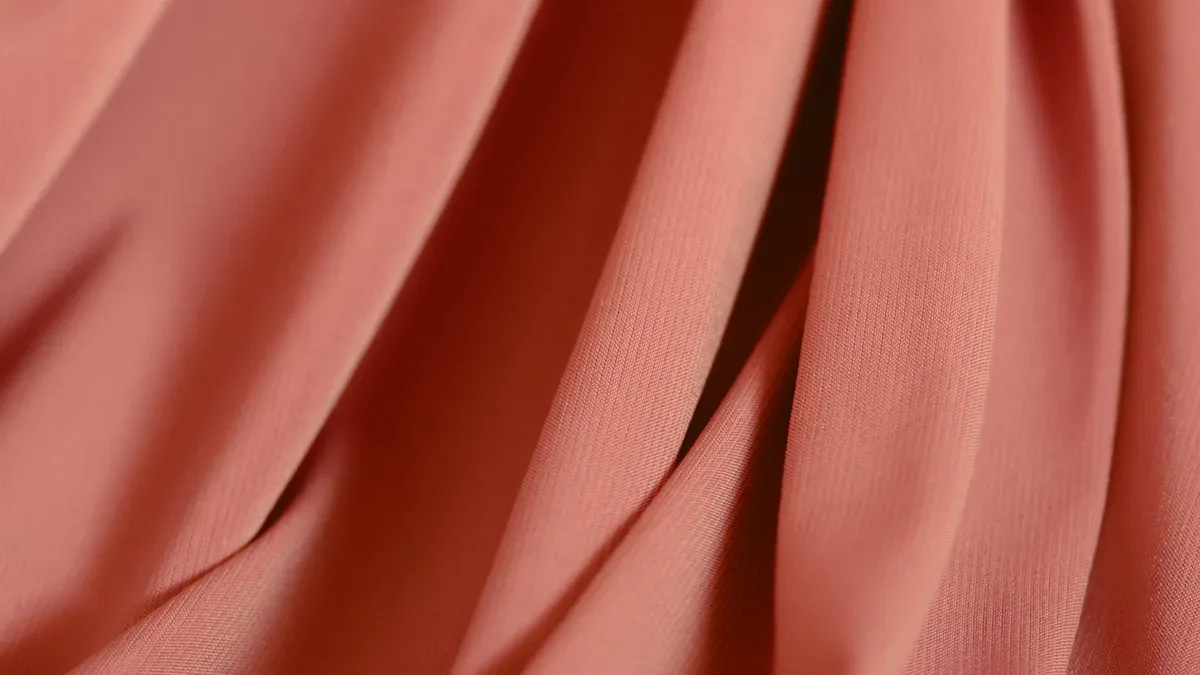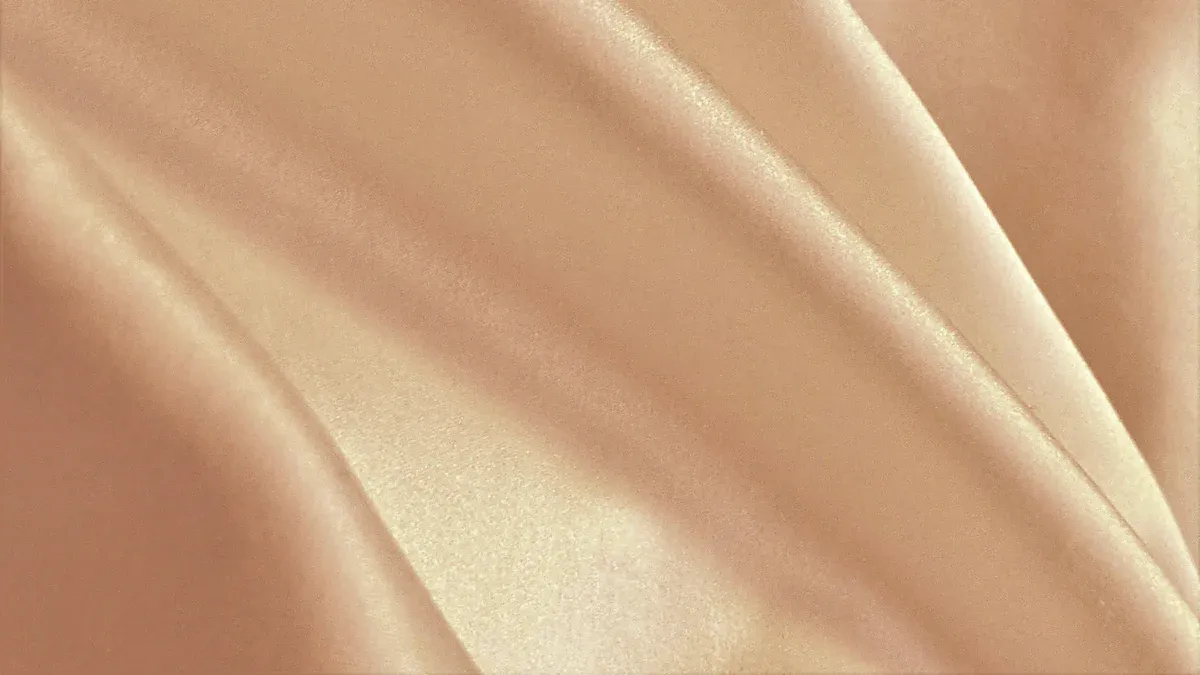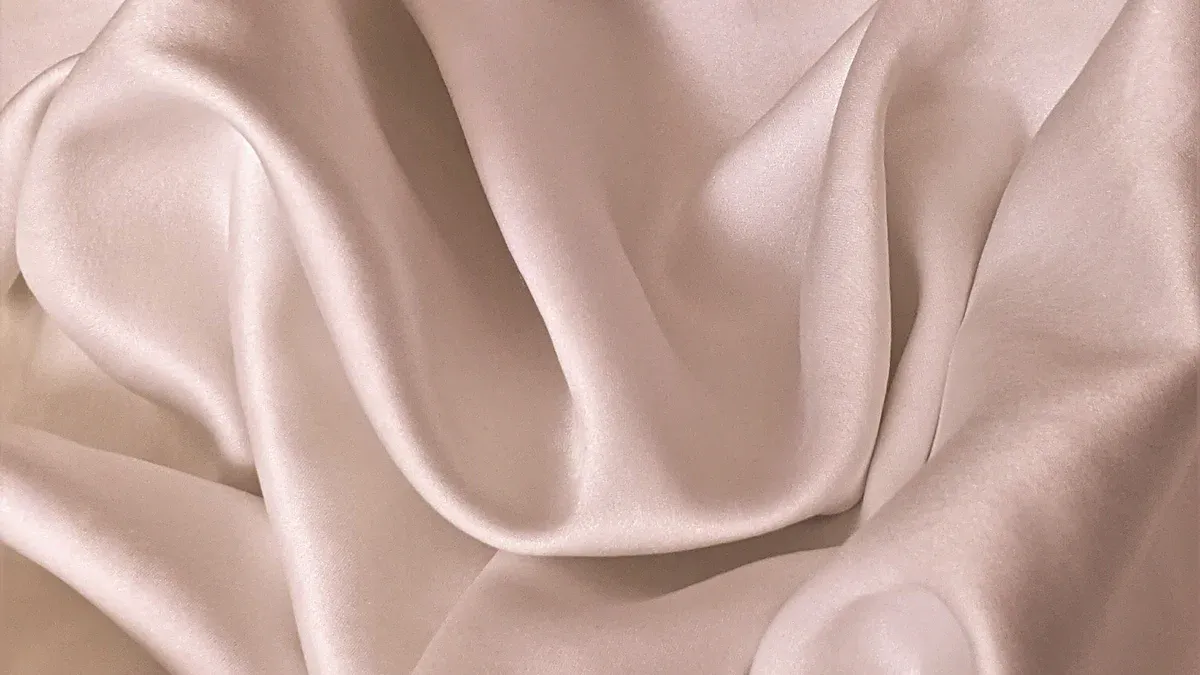
You want to make your satin fabric less shiny and more matte? You can try easy tricks like using matte sprays, gentle washing, or even a bit of powder. Some people press satin with a cloth or turn it to the matte side for a softer look. Remember, results can change if your satin is silk, polyester, or a blend. Always test a small spot first. With a little patience, you can keep that elegant feel while making your satin fabric suit your style.
Key Takeaways
- You can use matte sprays, gentle washing, careful ironing with a press cloth, or powder to make satin less shiny. – Always try any method on a small hidden spot first. This helps you make sure you do not hurt your satin fabric. – Pick gentle washing with cold water and mild soap to slowly make the shine less bright. This way, you will not damage the fabric. – Turn satin to its matte side or cut across the grain to make it look less shiny. You do not need to do extra work for this. – Do not use strong chemicals, high heat, or rough ways to clean satin. These things can ruin how satin looks and feels.
Satin Fabric Shine

Why Satin Shines
Have you ever wondered why satin looks so shiny? The secret comes from the way people weave satin. In satin, the threads float over each other in a special pattern. This pattern lets the threads lay flat and smooth on the surface. When light hits the fabric, it bounces off these smooth threads and creates that famous shine.
- The satin weave uses four or more threads that float over one thread below.
- These long floats make the surface very smooth.
- Light reflects evenly, so you see a soft, glowing shine.
- Satin often uses long, smooth fibers like silk. These fibers help the shine look even brighter.
You will notice that not all satin shines the same way. Satin fabric made from silk usually looks the most glossy. Polyester satin can look shiny too, but sometimes it feels a bit stiffer. Rayon satin often has a soft shine, while blends can look more or less shiny depending on the mix.
Tip: Some satin fabric has two sides. One side is shiny, and the other side looks more matte. You can use the matte side if you want less shine.
Challenges to Matting
Trying to make satin look matte can be tricky. The smooth surface and special weave fight to keep that shine. If you use the wrong method, you might damage the fabric or make it look uneven. Each type of satin reacts differently. Silk satin can be delicate, while polyester satin is tougher but may not lose its shine easily. Always test your method on a small spot first. This way, you keep your satin fabric safe and get the look you want.
Matte Sprays for Satin

Materials Needed
Before you start, gather everything you need. You do not want to stop in the middle of your project. Here is a simple list to help you get ready:
- Matte fabric spray (you can find this at most craft stores)
- Hairspray (as a quick alternative)
- Clean spray bottle (if you want to mix your own solution)
- Soft, clean cloth or sponge
- Masking tape or newspaper (to protect your work area)
- Hanger or drying rack
Tip: Always read the label on your spray. Some sprays work better on certain types of satin. Test on a small, hidden spot first.
Application Steps
You can use matte sprays or hairspray to reduce the shine on satin. Follow these steps for the best results:
- Lay your satin fabric flat on a clean surface. Use masking tape or newspaper to cover the area around your fabric.
- Shake the matte spray can well. Hold it about 8-12 inches away from the satin.
- Spray a light, even coat over the fabric. Do not soak the satin. Less is more.
- Let the fabric dry for at least 30 minutes. If you want a more matte look, add a second light coat.
- If you use hairspray, follow the same steps. Hairspray gives a softer matte effect and washes out easily.
- Hang or lay the satin flat to finish drying. Do not fold or touch the fabric until it is completely dry.
Note: Matte sprays and hairspray work best on polyester or rayon satin. Silk satin may react differently. Always test first.
Pros and Cons
Matte sprays can help you change the look of satin quickly. Here is a table to show you the good and not-so-good sides:
| Pros | Cons |
|---|---|
| Easy to use | Results are temporary |
| Works fast | May need reapplication after washing |
| No special tools needed | Can change fabric feel |
| Good for costumes or crafts | Not always even on large pieces |
Tip: Use matte sprays for special events or photoshoots. If you want a long-lasting matte look, try other methods too.
Matte sprays give you a simple way to make satin less shiny. The effect does not last forever, but it is great for quick fixes. Remember, every type of satin is different. Always test your spray and follow these tips for the best results.
Washing Techniques for Satin Fabric
Washing and Drying
You can make satin look less shiny just by washing it the right way. When you wash satin, use cold water and set your machine to the gentle cycle. If you want to be extra careful, wash your satin by hand. Gently move the fabric in the water. Never twist or wring it out. After washing, lay the satin flat on a towel or hang it up to air dry. Avoid using a dryer. High heat can make the shine even worse or damage the fabric.
Tip: Air drying helps keep the shape of your satin and slowly reduces the shine over time.
Detergents and Softeners
Choose a mild detergent when you wash satin fabric. Harsh soaps can hurt the fibers and make the fabric look dull in a bad way. You can add a little fabric softener to the rinse water. This helps relax the fibers and gives the satin a softer, less glossy look. If you want to try a natural method, add a splash of white vinegar to the rinse. Vinegar can help break down some of the shine without hurting the fabric.
Here’s a quick table for the best choices:
| Product | Good for Satin? | Effect on Shine |
|---|---|---|
| Mild Detergent | Yes | Gentle Dull |
| Fabric Softener | Yes | Softer Look |
| White Vinegar | Yes | Less Gloss |
| Bleach | No | Damages Satin |
Cautions
You want your satin to look matte, but you also want it to last. Never use hot water, bleach, or rough scrubbing. These can ruin the fabric. Repeated washing will slowly make satin less shiny, but too much washing can make it weak or faded. Always test your method on a small hidden spot first.
Tip: If you care for your satin with gentle washing and drying, you can get a softer, more matte look without ruining your favorite piece.
Ironing and Pressing Satin
Using a Press Cloth
You can make satin look less shiny by ironing it the right way. Always use a press cloth. This is just a clean, thin cotton cloth that you place between your iron and the satin. The press cloth protects the fabric from direct heat and helps prevent marks or burns. If you do not have a special press cloth, a plain pillowcase or a piece of muslin works well.
Tip: Lay the press cloth flat and smooth. Make sure there are no wrinkles. Wrinkles in the cloth can leave marks on your satin.
Heat and Pressure
Set your iron to the lowest heat setting that works for your satin. Most irons have a “silk” or “synthetic” setting. Let the iron heat up, then test it on a small, hidden spot first. Place the satin flat on your ironing board, shiny side down if possible. Put the press cloth on top. Gently press the iron down. Do not slide it back and forth. Lift and press instead. This helps reduce the shine without damaging the fabric.
Here’s a quick step-by-step:
- Set iron to low heat.
- Place satin on the board, shiny side down.
- Cover with a press cloth.
- Press the iron down gently for a few seconds.
- Lift the iron and move to the next spot.
Warnings
Satin can scorch or melt if you use too much heat. Never iron directly on the fabric. Always use a press cloth. Do not use steam unless you know your satin can handle it. Some types of satin, like polyester, react badly to steam. Always test first. If you see any change in color or texture, stop right away.
Note: Take your time. Rushing can lead to mistakes or damage.
A careful ironing routine can help you get a softer, more matte look on your satin. You keep the fabric safe and still get the style you want.
Powder and Starch Methods
Cornstarch or Baby Powder
You can use simple household items like cornstarch or baby powder to make your satin look more matte. These powders work by sitting on top of the fabric and breaking up the shiny surface. You do not need any special tools. Just grab a soft brush or a clean cloth. Sprinkle a small amount of powder onto the satin. Gently rub it in with the brush or cloth. The powder will stick to the surface and help reduce the shine.
Application Tips
Start with a small amount of powder. You can always add more if you need it. Use a makeup brush or a soft, dry cloth for the best results. Tap off any extra powder before you touch the satin. Work in light, even strokes. Try to cover the whole area so the matte effect looks smooth. If you see clumps, brush them away gently. Always test this method on a hidden spot first. Some satin fabrics may react differently, so you want to make sure it looks good before you treat the whole piece.
Tip: If you want a stronger matte look, you can repeat the process. Just remember to keep the layer of powder thin.
Temporary Effects
Powder and starch methods give you a quick fix for shiny satin. The effect does not last forever. If you wear or wash the fabric, the powder will come off. You may need to reapply it before each use. This method works best for costumes, photoshoots, or special events when you need your satin to look matte for a short time. You can remove the powder easily by shaking or gently brushing the fabric.
Note: These methods are safe for most satin fabrics, but always test first to avoid surprises.
Other Satin Matting Tips
Vinegar Sponge Method
You can try the vinegar sponge method if you want a simple way to reduce shine on satin. Mix equal parts of water and white vinegar in a bowl. Dip a clean sponge into the mixture and wring it out so it’s just damp, not soaking wet. Gently dab the satin with the sponge. Let the fabric air dry. The vinegar helps break down some of the shine and gives the fabric a softer finish. Always test this method on a small hidden area first. Some types of satin react differently, so you want to make sure you like the result.
Tip: Use this method for quick fixes or when you want to refresh the matte effect after washing.
Using the Matte Side
Many satin fabrics have two sides. One side shines, while the other side looks more matte. You can use the matte side as the outside of your project. This works well for clothing, accessories, or even home décor. Just flip the fabric over before you cut or sew. You get a softer, less shiny appearance without any extra steps.
- Check both sides of your satin before you start.
- Choose the side that matches the look you want.
- This is one of the easiest tips for a matte finish.
Cutting and Orientation
How you cut and place your satin can change how it looks. Satin has a grain, which means the threads run in a certain direction. If you cut the fabric across the grain (crossgrain), you might notice less shine. Try laying out your pattern pieces in different directions to see which way gives you the best matte effect.
Here’s a quick table to help you:
| Orientation | Shine Level | Matte Effect |
|---|---|---|
| With the grain | High | Low |
| Crossgrain | Lower | Higher |
Tip: Experiment with small scraps first. You can find the best way to use your satin and get the look you want.
What to Avoid with Satin
Damaging Methods
You want your satin to look great and last a long time. Some methods can ruin the fabric fast. Stay away from these damaging tricks:
- Sanding or Scraping: Never use sandpaper or rough tools on satin. This will scratch the surface and leave ugly marks.
- Harsh Chemicals: Bleach, acetone, or strong cleaners can break down the fibers. You might see holes or faded spots.
- Abrasive Powders: Some people try rough powders to dull the shine. These can grind into the fabric and cause pilling.
- Direct Heat: High heat from an iron or hair dryer can melt or scorch satin. You may end up with shiny patches or even burn marks.
Note: Always treat your satin gently. If you use the wrong method, you could damage it for good.
Common Mistakes
Even if you try to be careful, some mistakes can happen. Here are a few things to watch out for:
| Mistake | What Happens | How to Avoid |
|---|---|---|
| Too Much Heat | Melts or scorches fabric | Use low heat and a press cloth |
| Too Much Sunlight | Fades color, weakens fibers | Dry in the shade |
| Rubbing or Scrubbing | Causes snags and fuzz | Blot stains, don’t rub |
| Skipping a Test Patch | Surprises and damage | Always test a small area |
You might want to rush, but take your time. Always test any new method on a hidden spot first. If you see any change in color or texture, stop right away. Your satin will thank you for the extra care!
Suerte Fabric Satin-Weave-Fabric
Product Features
If you want your projects to stand out, you should check out Suerte Fabric. This company offers high-end satin fabric that feels soft and looks elegant. You can pick from several types, like silk, polyester, rayon, or even blends. Each type gives you a different feel and shine. You might love the smoothness of silk or the easy care of polyester. Suerte Fabric also lets you choose from many finishes. You can go for a classic glossy look, or you might want something more matte, sanded, or brushed. Some finishes even add a soft, velvet-like touch. You get to decide what fits your style best.
Tip: If you want a special color or finish, Suerte Fabric can customize your order. You can ask for samples to see and feel the fabric before you buy.
Application Scenarios
You can use Suerte Fabric’s satin for so many things. If you love fashion, you might use it for elegant evening gowns or bridal attire. Designers often pick this satin for wedding dresses because it drapes so well and looks stunning in photos. You can also use it for stylish shirts, pajamas, or even accessories. At home, satin fabric works great for curtains, pillow covers, or sofa throws. It adds a touch of luxury to any room. If you work with stage costumes or need fabric for performances, this satin shines under the lights and helps you create an eye-catching look. Some people even use it for sportswear or special banners.
If you want to try Suerte Fabric, you can reach out for samples, prices, or custom orders. Their team will help you find the perfect fabric for your next elegant project.
You have lots of ways to make satin fabric look matte. Try matte sprays, gentle washing, careful ironing, or even a bit of powder. Always test a small spot first to keep your fabric safe. With a little patience, you can create an elegant appearance that fits your style. Want a truly elegant project? Check out Suerte Fabric for beautiful satin and custom options.
FAQ
Can I make any type of satin look matte?
You can reduce shine on most satin fabrics. Silk, polyester, and rayon all respond differently. Always test your method on a small, hidden spot first. Some satins may keep a slight sheen, even after treatment.
Will washing satin always make it less shiny?
Washing can help dull the shine over time. Use cold water and gentle detergent. Avoid hot water and harsh chemicals. Too much washing can weaken the fabric, so check your results after each wash.
Is it safe to use powder on colored satin?
Yes, you can use powder on colored satin. Test a small area first. Some powders may leave a white cast on dark fabrics. Brush off extra powder to avoid streaks.
How long does the matte effect from sprays or powder last?
The matte effect from sprays or powder is temporary. It may fade after wearing or washing. You might need to reapply before each use, especially for special events or photos.
What should I do if my satin gets damaged?
- Stop using the method right away.
- Blot, don’t rub, any stains.
- Take your fabric to a professional cleaner if you see burns or color changes.
Quick action can help save your satin!



